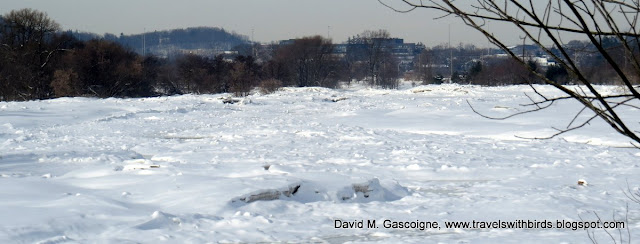25 February 2018
I was advised yesterday evening by our good friend, Anne Morgan, that she and her husband Alan, along with Virgil and Beth Martin had been hunting for Snowy Owls (Bubo scandiacus) and had met with resounding success. Even though we had a busy day ahead of us Miriam and I decided that we could spare a couple of hours to search for these northern birds who will soon be leaving our area. It was sunny and the temperature was 8°C, unusually warm for this time of year.
We had not gone far when we saw several Red-tailed Hawks (Buteo jamaicensis) gambolling in the sky, ostensibly involved in courtship flights. The spectacle they put on is quite amazing, twisting and turning, tumbling like circus acrobats. We were able to photograph this individual before it left its perch to join in the fun.
The Region of Waterloo is the epicentre of Mennonite residency in Ontario, and being Sunday morning, the meeting houses were full. The horses, all lined up at the hitching rails waiting for their owners to return, presented quite a sight, as did the conveyances, each with a "Slow Moving Vehicle" sign emblazoned on the back.
The fact that it has been so mild of late (and is predicted to continue warmer than usual) means that the sap has started to flow in the Sugar Maples (Acer saccharum), much earlier than is normal, and many trees bore telltale sap-collecting pails. Plastic has pretty much taken over now, but the old metal pails still in use not many years ago were certainly better suited to a rural landscape, and seemed a natural part of the annual cycle.
In fact, many large operations no longer use pails at all and have a network of plastic pipes connecting the trees to a central collection area.
Our first Snowy Owl was a male, quite far off and sitting on the last patch of snow in the field.
We drove along keeping a keen eye peeled for others and finally our efforts were handsomely rewarded. A female was located hunkered down behind a stump, sheltering from the wind. And it was very close to the road. By using the car as a blind, and basically letting the car roll very slowly, with intermittent stops, we were able to get a series of photographs.
This truly is a magnificent creature and it matters not how many times I have seen one, a sense of awe and reverence takes over. It is akin to being in the presence of greatness.
Tomorrow looks fairly open with only a few discretionary chores to take care of, so I think we might embark on a search again. After all the Snowies will soon be leaving us and we will have to wait another nine months or so until we see them return. We wish them good hunting on the tundra, with plentiful prey. May they raise large families to send south to fill our hearts with joy next winter.
Addendum to this post 26 February 2018: We went out again today and discovered another seven Snowy Owls. Remarkable!
Also - Only in America: https://www.youtube.com/watch?v=fB7MwvqCtlk
Addendum to this post 26 February 2018: We went out again today and discovered another seven Snowy Owls. Remarkable!
Also - Only in America: https://www.youtube.com/watch?v=fB7MwvqCtlk





































































.svg.webp)













